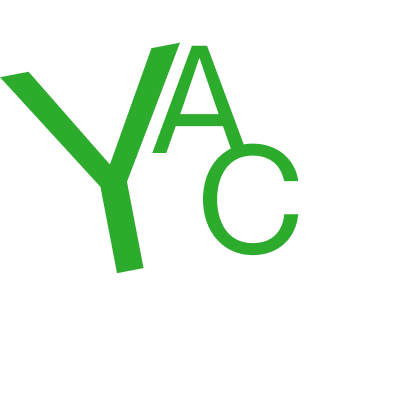Angus McCrum
Interview by Elaine Tam
-
Published in October 2020
-
An artwork, in this instance, does not start with the artist as autonomous convenor or arbitrator, but with a prehistory of the materials themselves. This prehistory, as I have come to learn, is one often called forth by the simple act of wandering; from Robert Walser to W. G. Sebald, the Situationists to the flâneur, the walk has been a fulcrum for creative activity and thought. For Angus McCrum, exploring the South Downs instills in him a distinct awareness of the hospitality of his environment, and the teeming generosity with which it unfurls. Take for instance the waymarker — a frequent referent, named and unnamed — which the artist perceives as a totem of goodwill. This earnest understanding of one’s surroundings bears gifts; they have come as detritus, debris, donations, digressions and detours. Might this then be work that at once deploys and revises the stable of strategies heralded by arte povera?
The material histories and cultures of his found objects are re-invoked by McCrum’s treatment, that is, intervention at the level required for assemblage. As such, even its most basic, practical features take on designerly, aesthetic properties; dowel rods, zippers and rubber bands behave as choice elements traversing the plane of the artwork itself. The denouement of these actors is a non-representational account of his findings: the complementarity of inchoate and rudimentary forms that, with degrees of longing and nostalgia, point to bygone times. The achievement of each work is that it suggests, rather than inculcates, a soft-focus vision of the present-past, an enigma which can only ever wholly belong to it.
-
I wanted to start with how we met. You were preparing to move to Berlin, and giving away all the works in your studio.
The original idea to do that came from the work itself. So many of the materials that I use are found; I usually just pick them up on walks. I didn’t know if many people were going to come to the open studio, I didn’t know if I’d be giving anything away at all, they’re only little things, but it ended up being practically everything which was a really nice surprise.
Yes, I was one of those people! And in that respect, the works are never implicated monetarily in an economy of exchange or transaction. They’re properly gifts.
Some people wanted to swap things, but I just wanted them to have it. Everything ended up going the way it should’ve gone.
Some artists, when they undergo a major transition, in your case perhaps moving, they destroy the existing corpus of work. So as to relinquish old ideas or ways of working, with the view to start anew...
Yes, there is a transition happening, something’s happening. I can’t work exactly how I used to because my circumstances have changed a lot. Maybe that’s a healthy thing. Right now, I’m working in the kitchen, slash the bedroom, slash the studio. I have to be really tidy and clean up after myself. Some of the stuff I’ve made recently is possibly a little more fussy because I can’t make a mess or any loud noises. But there are a couple of glass pieces I’ve been working on, maybe that’s where the messy stuff is happening, sandwiched between layers of glass.

Salt way, 2020, Glass, paper, oil, 29 x 36 cm
I suppose it takes more pre-planning, and the inability to leave things unfinished must have an effect… but also the work’s components or contents, as the things you find now differ.
Before this I lived in London, and on the South Coast — where I’m from. It’s easy to go on a walk somewhere remote there. Take for instance the South Downs, I’m familiar with the geography, I know the history. In Germany I can’t do that so much, because I’m totally unfamiliar with where I am. It’s different when you don’t feel like you have a connection with the area, I can’t just pick something up. So some of the recent stuff has literally been rubbish, twigs, discarded metal, things that feel anonymous. I just don’t know the place well enough to find what I’m after; I don’t even know what I’m after at the moment, really. I’ve also been using bits I find in the kitchen too like flour, wine and mustard. They make a good, sticky paste.
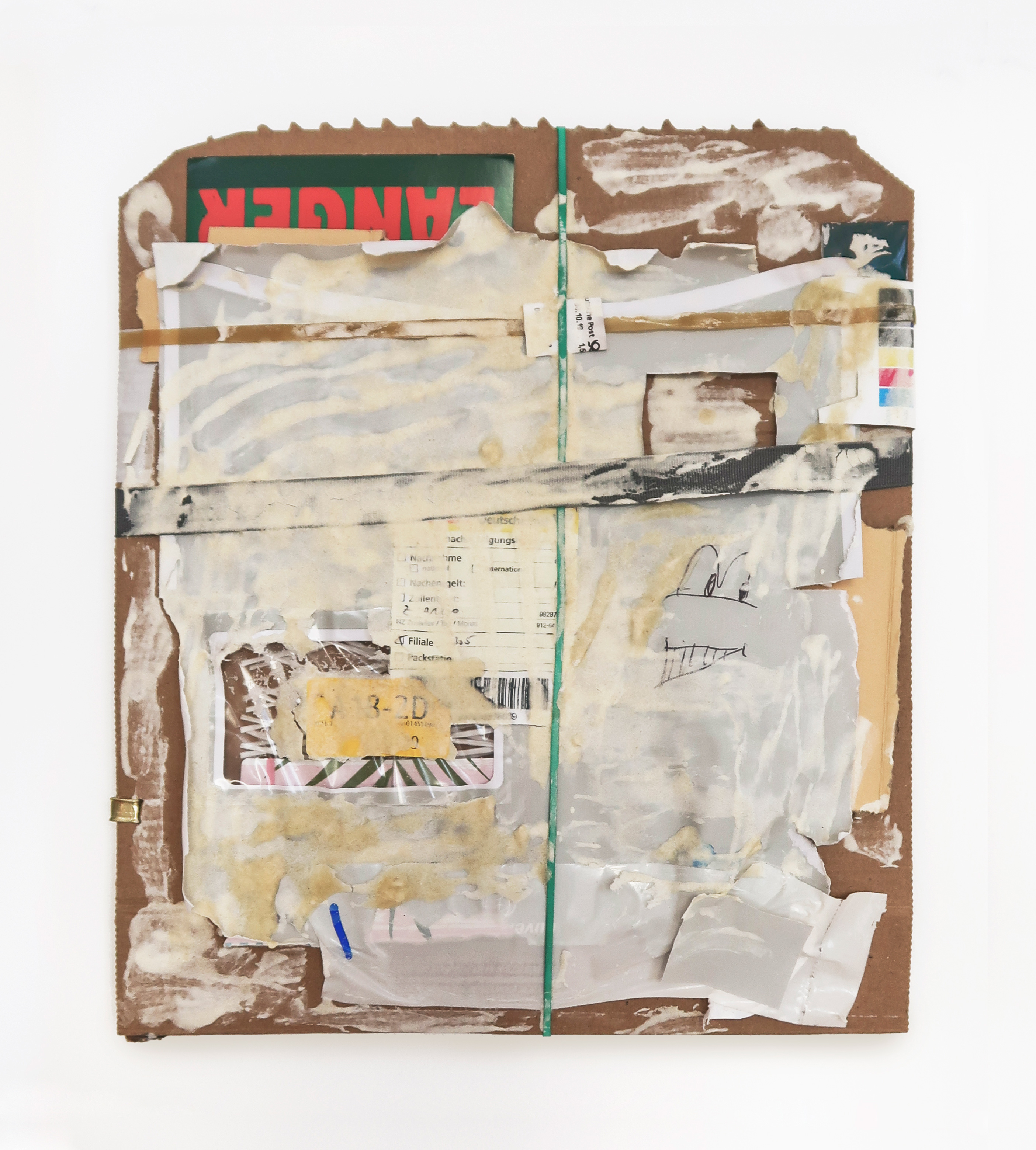
Karl.s Straße 1, 2020, Card, elastic, paper, ribbon, dough, 30 x 25 x 4 cm
Would you say that, by having a relationship to the historicity of your materials, your work is somehow autobiographical? Insofar as it has to do with where you’re from, the act of walking, the event of an encounter which is tied to a location, the location which is also the story of the materials. I wouldn’t say autobiography is a distinct feature of the work at all, but potentially serves a performative function or role in the artistic process.
After what I’ve just said and you’ve just said, it would be hard to argue that it wasn’t. I’d like to think of it as biographical — stories of the land and its history — more than just my relationship to it. I’m putting the stuff together, but I hope it emphasizes the beauty or peculiarities of the objects I collect. Pyrite, or large lumps of chalk… I once found a bit of a meteorite… all of these things are from the South Downs.
What was your experience of growing up there?
We lived in the middle of nowhere, right at the edge of a forest on a road where cars drive very fast. It’s kind of sad because some of the stuff I’ve used in my works are things I’ve had since I was a kid. It hasn’t changed since I was a child; I still love that landscape, I miss it so much. It has all these strange lumps and bumps on the hills. When I was young I had no idea what they were, but since then I’ve learnt they’re burial mounds, hill forts and cross dykes, ancient stuff. I feel much less of a tourist now than I did when I was a kid.
Burial mounds?
South Downs is littered with them, and cross dykes — the South Downs has the most concentrated number of cross dykes in the whole of the UK. These are vast sometimes more than one hundred meter long tubes of raised earth, five or six in a row. They still don’t know exactly what they were used for, likely field or boundary markers, but they could’ve also been used for ceremonies or rituals.
Your works with precariously balanced stones or stacks do reminisce burial mounds. The way in which the gestural manifests, its articulations, seems to have its origins in such discoveries in the landscape. Even the bound pieces, using what looks like tarpaulin, remind me of the coverings that keep hay bales safe from rain. There’s some semblance of these phenomena in your work, I believe.

Drawen, 2019, Fabric (nylon/cotton), metal fittings, copper and pine, 46 x 36 x 16 cm
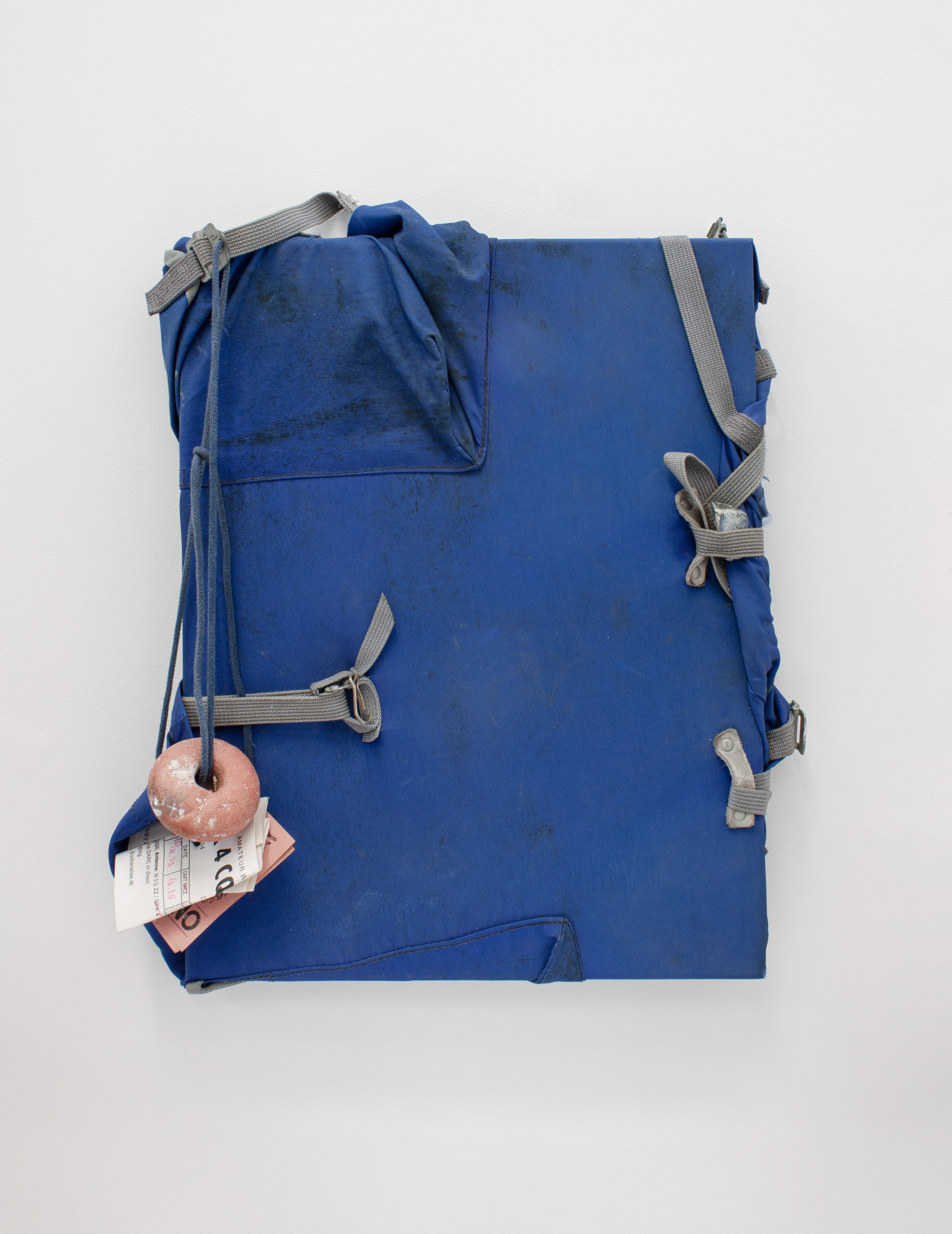
Up, toward, 2019, Fabric, foam, qsl cards and serpentine, 60 x 46 x 15 cm
Absolutely.
And there’s a “primitivity” about how you treat stone for instance. The sculptures are like sketches, with rudimentary markings. And maybe that’s to do with the tools you use, or lack thereof. How do you relate to old technologies? Do you ever refer to a particular historic period?
I call some of my finds “speculative artefacts”. That’s when I’m fairly sure it is what it is and I’m happy to live with its questionable authenticity. For instance I’m positive I once found an arrowhead sharpener. Then, there was a stone vessel I made, or rather, made with tools that I had made. It was just to see what I could do, if it’s worthwhile at all. It feels like a way to honour the making, and it’s especially interesting if I can include objects that might’ve also been made by human hands many many years ago. But to answer your question: it’s the Mesolithic period that I find the most interesting I think.
Forgive my ignorance, but if memory serves me well enough, the Mesolithic period sits between the Palaeolithic and Neolithic periods, right? The former marking the introduction of simple tools to ways of life, the latter farming —
Yes exactly. In the Mesolithic period we didn’t own land, crops, or herds of animals yet, or we were only just beginning to, it was a transitional time. It was probably a brutal and very difficult way to live. Broadly speaking there was far less economic inequality and you mostly had to worry about the elements, and your luck with self-sufficiency.

Coventina, Breath!, 201, Limestone and artefacts (spindle whorl fragment and musketball), 40 x 21 x 12 cm
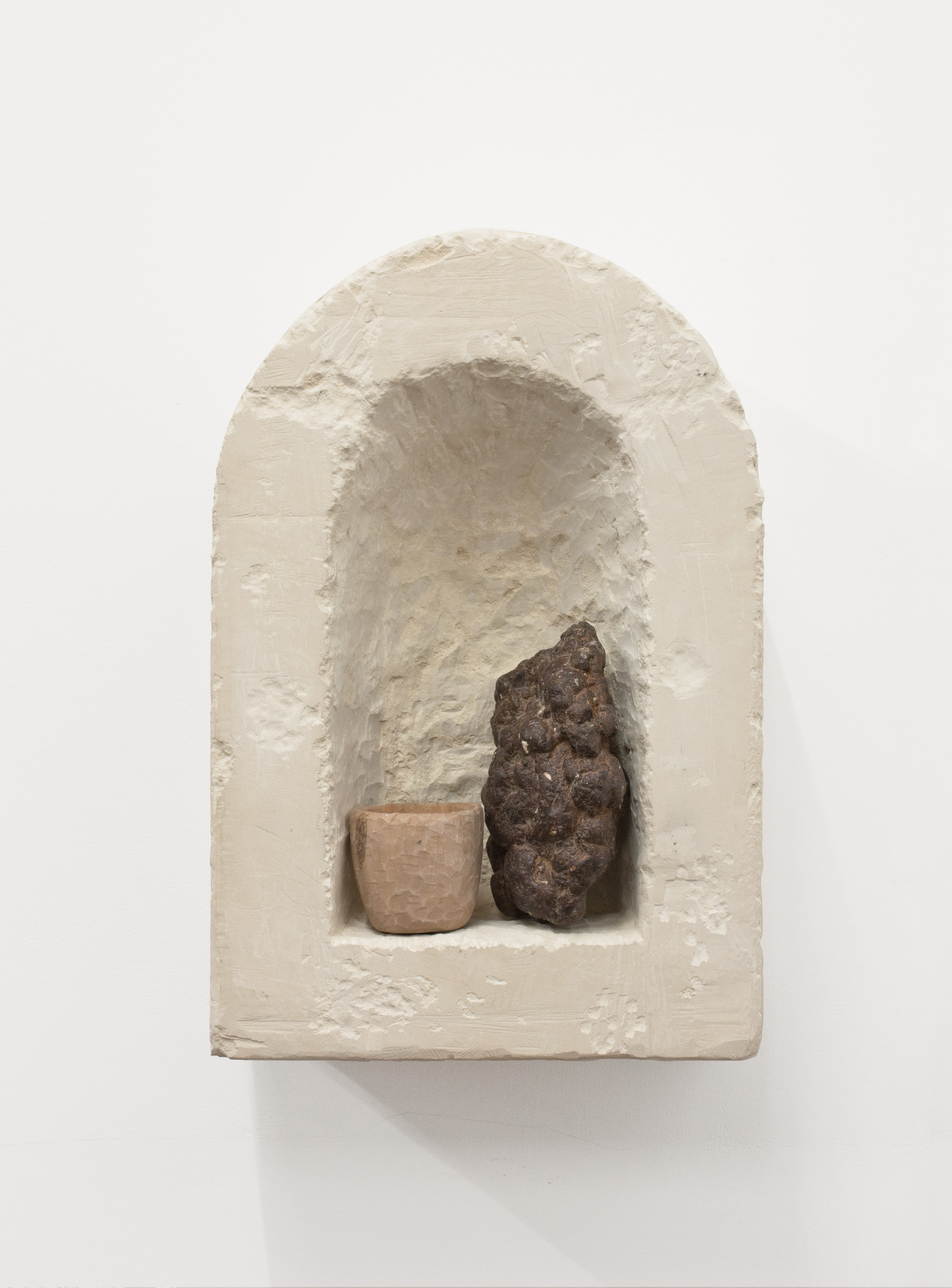
Rest here, 2019, Limestone, pear wood and iron pyrite, 39 x 30 x 18 cm
It’s the last spell of time before territorialisation, right?
The Neolithic Revolution was the beginning of the production of surplus, so the Mesolithic period feels very much pre-capitalist in that sense. I’m definitely not an authority on the subject, but I read that somewhere, and think that’s quite poignant.
Yes. In the Neolithic period they started to have more permanent settlements, so I understand that’s when territorialization starts to be a thing. Proprietary concepts and sentiments carve up the land. Land ownership — and the ability to govern, protect, exploit it — is certainly a predecessor to capitalism as we know it.
And animal husbandry — humans learnt to domesticate livestock, and grow fields of wheat on their own land. You started to have an excess.
Yes, as it’s quite impossible to cultivate, barter or otherwise deal with excesses when you’re nomadic and on the move. In contrast, nomadic peoples’ primary preoccupation seems to tend more towards fulfilling communal living and needs.
There was this amazing show called Ice Age Art at the British Museum in 2013, it was one of the best shows I’ve ever seen. There was a wooden carving of an anthropomorphic figure from Southern Germany, part lion part human. They called it art. But I would just love to know what people believed in at the time, how religion worked, if and how they worshipped.
Yes, our conception of art now is incomparable to what we might’ve conceived then. What we retroactively or retrospectively call “art” tended to have either practical or symbolic uses in their own time.
Yeah exactly, I think it was far more complicated.
Some of the works you create seem to have a delicate suggestion of ritualism about them. The wood carved cups, or the stone you carved out to look like an altar or shelter. And this is my line of thinking: while we refer to artefacts as artwork, your work calls into question how objects were purposed in the past and, at the same time, how designerly or functional qualities are also in many ways aesthetic.
That piece with the cup is made of pearwood. I was making the cups by hand rather than with a lathe, they are rudimentary and flawed. I’ve made a few of these cups now — another cup piece is called Rest by the Ditch — it’s kind of my representation of charity, or the image I use to represent charity. Then, the altar you mention, was made to house one of the biggest pieces of pyrite I found, a huge bulging piece. It used to be incredibly valuable as it was used to make fire. Maybe it would’ve been splintered and shared out.
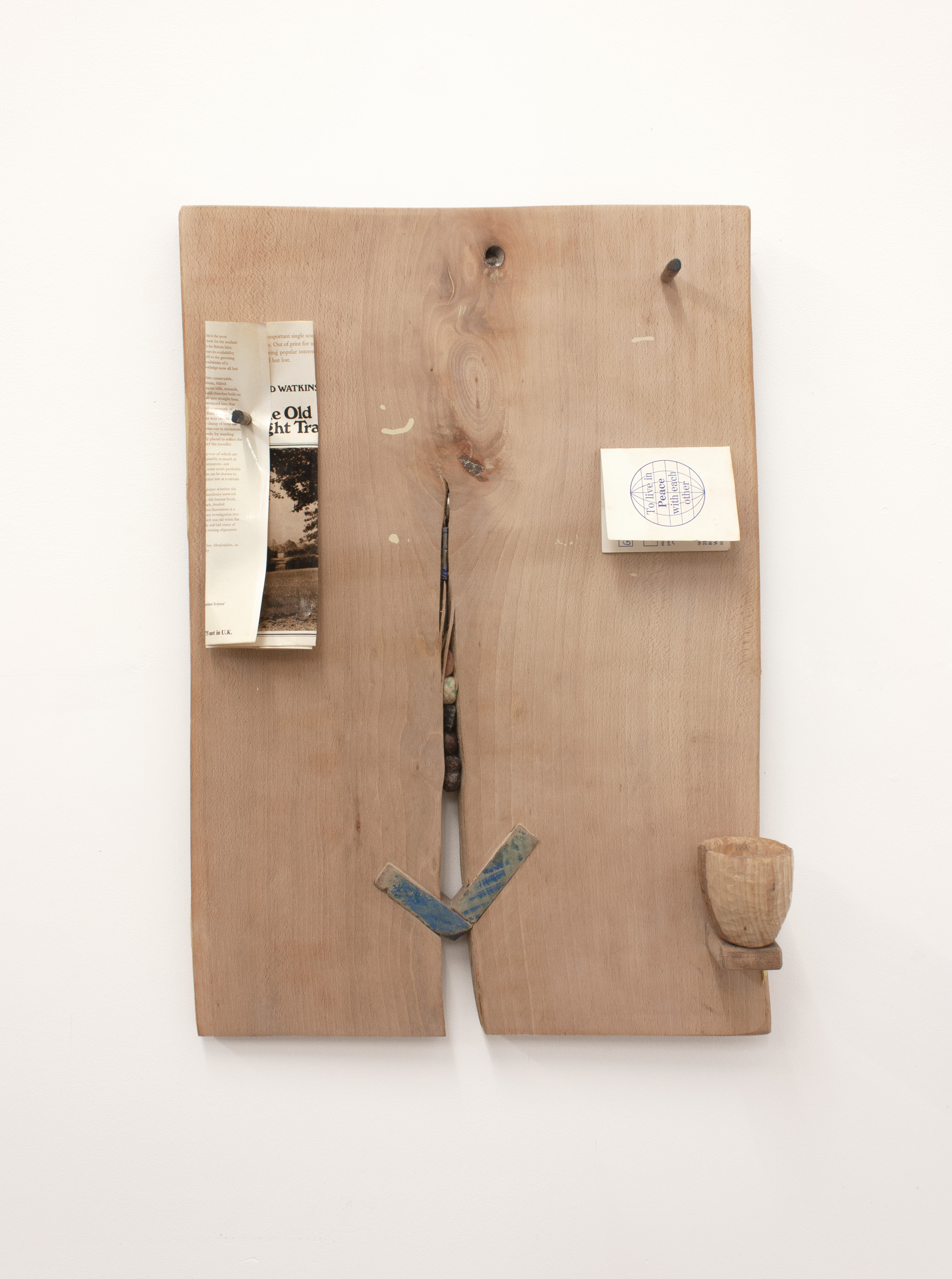
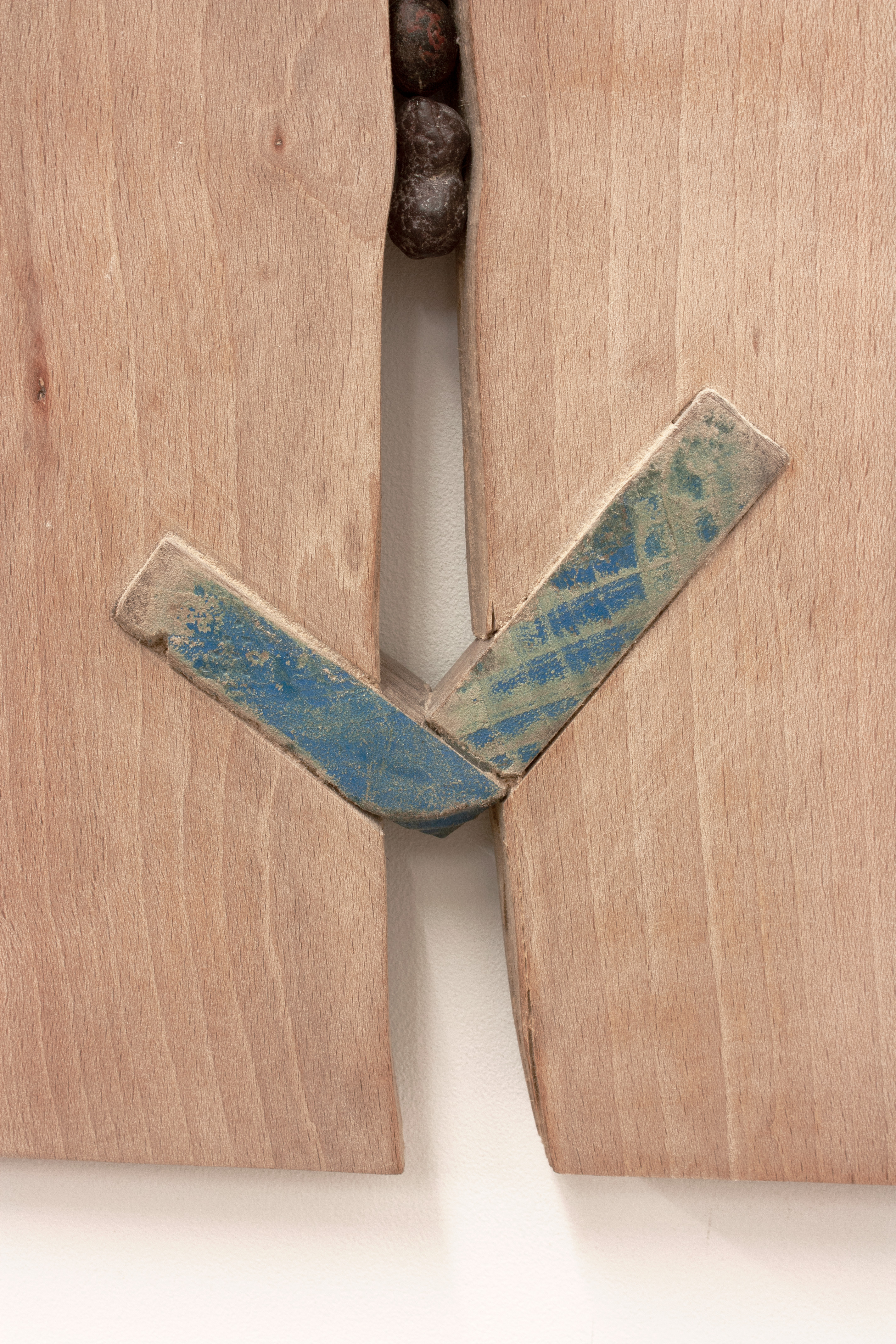 Waymarker, good will, 2019, Beech, elm cup, cover of The Old Straight Track by Alfred Watkins, paper, obsidian, serpentine, Swiss Franc, iron pyrite, rope, brick, walnut, 81 x 50 x 12 cm
Waymarker, good will, 2019, Beech, elm cup, cover of The Old Straight Track by Alfred Watkins, paper, obsidian, serpentine, Swiss Franc, iron pyrite, rope, brick, walnut, 81 x 50 x 12 cmIt comes back to this idea of the distributive economy of the Mesolithic period. The mere fact you gifted all your works honours that way of thinking, in a way, juxtaposing the commodification of art that is pervasive today. The emergence of themes such as care, mutuality, charitability seems more obvious to me now, though I should’ve been able to guess it earlier. The small bit of found text “Courtesy and Friendship” was actually the starting point of our mail-art project, the edition for Kingsgate Postal Service. The first iterations of which were something close to collage.
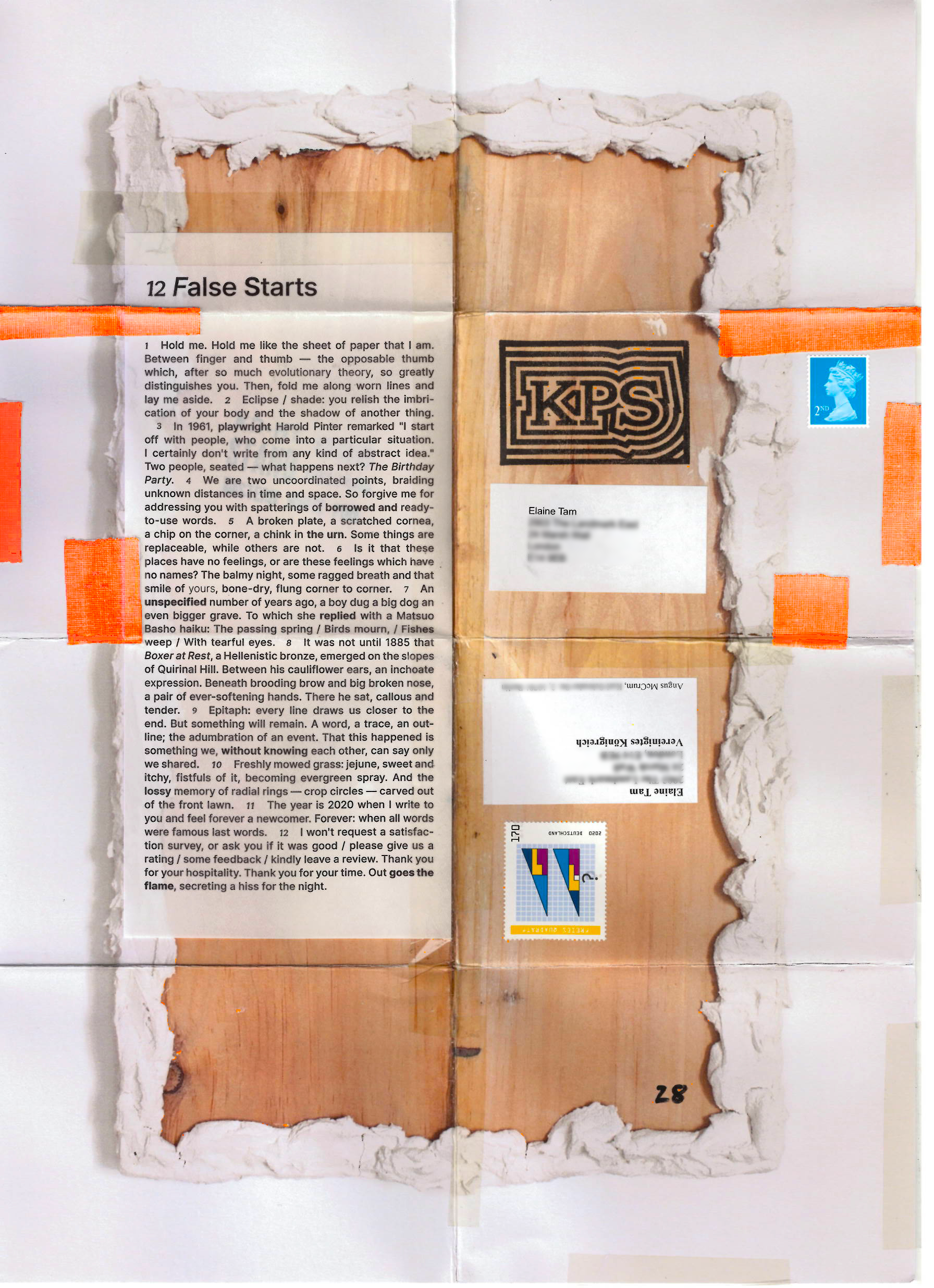 12 False Starts, edition of 120 mail-art for Kingsgate Project Space
12 False Starts, edition of 120 mail-art for Kingsgate Project SpaceFor sure. The edition we made was a far reaching collage — a diagram of ideas. What’s interesting about it is that we had all these visuals in the beginning and then… it felt like everything was filtered into your writing, and then the text was what took on the property of collage, taped onto the poster.
You created a constellation of images, feelings, ideas in space, what I suppose you would call assemblage in sculpture. I didn’t want to be too representational, describing your work, yet it was obviously my main source of inspiration. The Boxer at Rest, disparate references like that, became pointers, ones that didn’t call for a perfect, overarching narrative. Then, the act of tabula rasa — you made this decision to opt for an empty plank as a background — which then meant that all the visuals existed only in the text…

The Bronze statue Boxer at Rest at time of discovery in 1885, Quirinal Hill, Rome.

“Akbash in the manger” image found on Angus’ old USB, still downloadable from desktopwallpaperz.com.
The writing behaves like lyrical captions to the lost images. But they’re not just images, there are whole stories, and trains of thoughts, and memories. On reflection, the entire drawn-out process was totally necessary.
While we were working together I had a question rattling around the back of my head: is nostalgia a part of your work? Presences, absences, we left a lot of negative space. And there was that photograph of the dogs you discovered on your old USB stick.
If someone says something is nostalgic, I think it sometimes comes across as negative. But yeah, I’m extremely nostalgic — rose-tinted glasses.
According to its Greek etymology, the word nostalgia breaks down to “return”, “home” and “pain” — quite literally a longing for home.
I’ve been homesick forever since I left the Downs. It’s not even just the countryside, it’s that specific part of the countryside. Growing up with dogs, being near that landscape. I want to re-live it.
Since you recommended to me Sebald, I’ve started reading Rings of Saturn. Reading him is like being taken on a walk, traversing pastoral pleasures. Both the content and form is a walk, being led somewhere pictorially and mentally. Do literatures like that weave their way into your work?
Memory; the way he links so many things together — and the metaphysical walks you take with him, they’re walks I won’t go on with anyone else. He deals with painful topics so tenderly. It really resonates with me. Much of the work I make is really about the history of the land, where the materials are collected, and he’s the master of describing a place and its connections through time, both local and faraway. I always try and make as much time as I can for reading... but last summer I got bitten by a tick and caught Lyme disease, and during that time I couldn’t commute by bike and I really valued the extra hour or so of reading I could do every morning and evening on the tube. I was lucky though as I really didn’t have it that badly compared to so many others.
Were you camping? Is that how you got bitten by the tick?
There’s a beach in South Cornwall called Soapy Cove where they used to mine Talc. I wanted to find some. While looking for a shortcut, my partner and I had to push through about 40 meters of neck-high bracken around where they keep a lot of cattle. I think that’s where it latched onto me; that’s my theory anyway. When I found it on me much later, I pulled it off and kept it; I put it in my mum’s freezer. I was going to use it but I never did.
Sorry, what’s in your mum’s freezer?!
The tick! I was imagining I was some type of artist that I’m not, that I’d use it somehow. It’s still there, she hasn’t thrown it out.
I like this chain of events informing other events. That’s why the tick is an interesting junction. It represents the detour — the detour en route to collecting Talc for your work, which lead you to reading more, which now surely informs your work.
I’m going to get that tick next time I visit my mum.
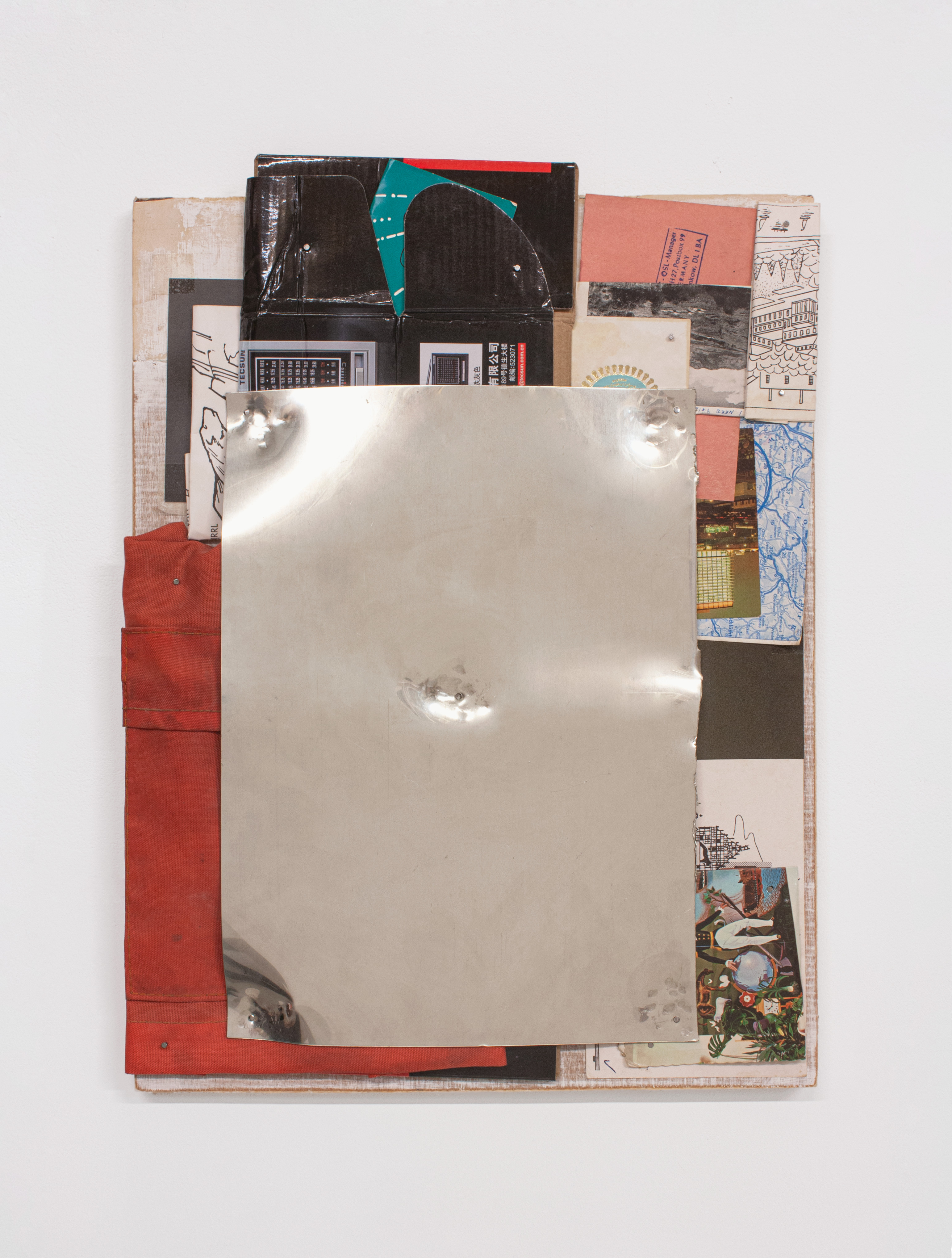
Waymarker/Local Service, 2019, Pewter, plywood, nylon, paper, cardboard, 48 x 36 x 10 cm
You mentioned “imagining some type of artist that you’re not”. What qualifies as a successful work for you, and why? Before you had mentioned artists like Henrik Oleson…
Katherine Pleydell-Bouverie, I think everything I’ve seen of hers is a successful work of art. She developed and recorded tons of glazes — ash glazes — using leaves, fruits and vegetables. She was inspired by Bronze Age urns. Everything she made seems perfect; the colours, the forms, the simplicity.
There’s this almost effortless harmony about her work. We were speaking once before about not wanting the artwork to feel contrived, so maybe instead of a perfect work, there are things to avoid when making work. Do you like Noguchi?
I love Noguchi, JB Blunk as well, who was his good friend. It was Noguchi who introduced him to Rosanjin. There was a great show of his work at Kate McGarry a couple of years ago. And Lutz Bacher! The way she worked with found objects… her humour and darkness.
Is humour important? Humour always cuts through what could otherwise be contrived. Or maybe it’s better understood as a lightness, one which speaks through giving all your works away, for instance.
I’ve been asked that before. Well, there’s a glass work I’ve been working on that I mentioned before, and there’s an image of a dog. We were going to adopt a dog, but he was utterly terrified of strangers. He was a nervous wreck — it took about an hour before he would let us touch him. He needed to be away in the countryside. Before we went to visit, I bought this little dog toy for him on my lunch break. This is the tag from the toy that I bought.
 From the way, 2020, Glass, paper, glue, oil, 36 x 29 cm
From the way, 2020, Glass, paper, glue, oil, 36 x 29 cmThe work is a little dedication to the dog you’re not going to have...
[Laughs] Nostalgia must play a big part. And humour too, yeah.
Have you ever done this exercise of looking back to your works from 2018, and thinking about what has changed? In addition to layering, I feel like there’s more binding, knitting and knotting going on.

On the side of the route, 2019, Cotton, chalk, yew, paper, obsidian, flint, pine, steel, 65 x 40 x 11 cm
Yeah you’re right. I think I’m trying harder to keep everything together. I guess I’m still figuring out what I can do, or what’s available to me. Sometimes you think you’re not that person, but the more I make things, the more I realise that I’m limiting myself in that way without realising it. I’m fiddling with things constantly. An easy way to bring two things together is to tie them up.
A work I really like is Above Laines, it seems the first of its “kind”, I wonder if that signalled a new trajectory in your work at all? Especially now that I see the new work with the glass, the swathes of white paint wiped, I’m reminded of it. And the image I sent you of that glazed door while I was filming in Weston-Super-Mare.
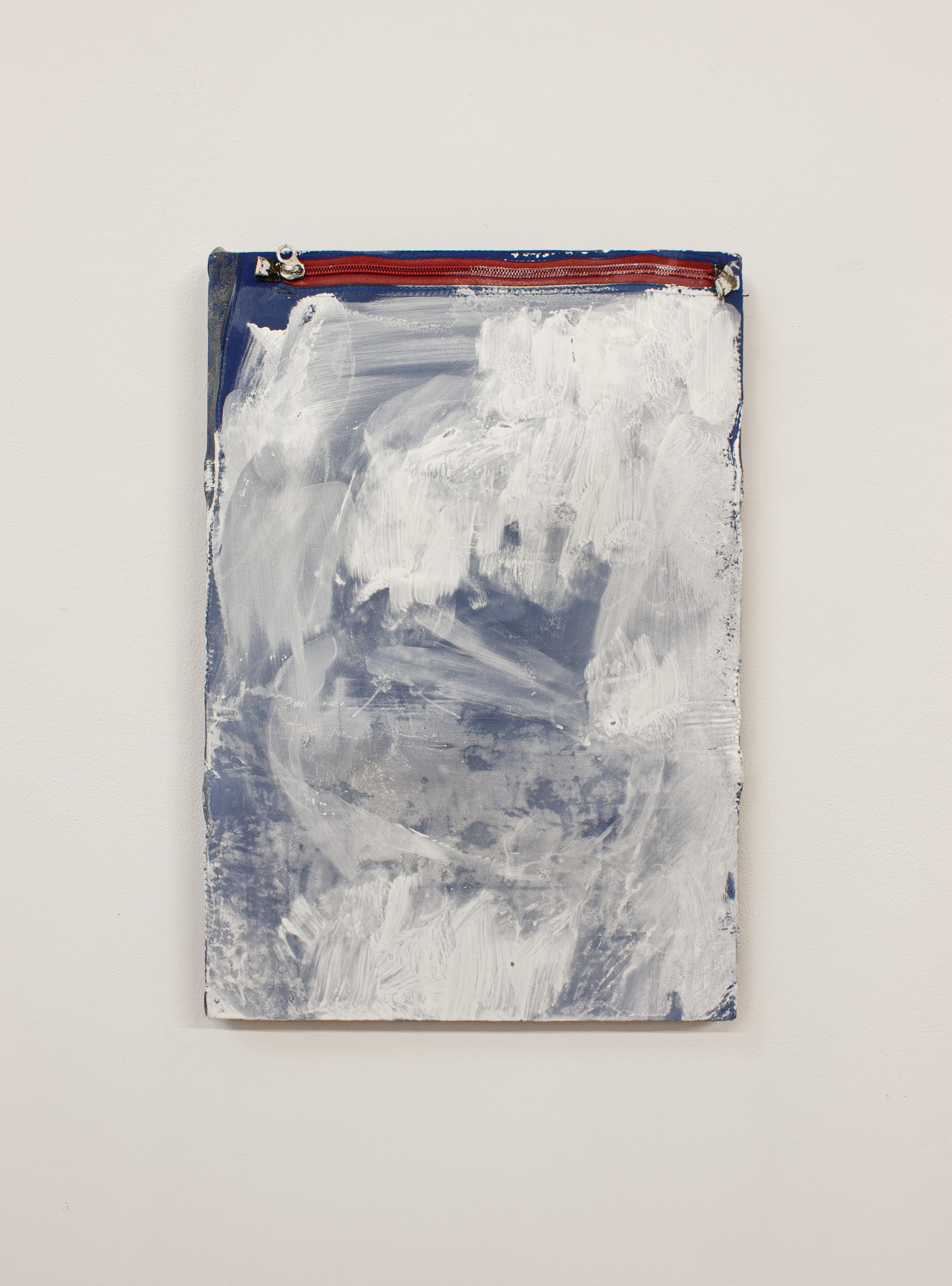
Above Laines, 2020, Nylon and acrylic, 50 x 30 x 12 cm
Iphone image shot in Weston-Super-Mare by Elaine, sent to Angus.
Jesus Christ! That, I think, has really influenced me. It’s something else that I didn’t know was available to me… that I could do that. I feel I’m often too scared to experiment. I didn’t think I could or would be working with glass. But then you look at people like Carol Rama, Heidi Bucher or Roger Ackling — and you realise you’re not really doing anything at all.
Actually, I only sent you that picture because I had seen Above Laines, and thought you would be interested. What’s the title about though?
“Laines” is old Sussex dialect for the flood plains, or flat stretches, beneath the Downs. It was somewhere I camped a lot and hung out as a teenager. This is half of an old rucksack. I used the other half for another piece — Up, Toward. It was great to be able to fill up that pocket again, too. It’s stuffed with another part of the backpack. Its swollen profile looks like the hills. It’s eaten itself.
It carries itself.
Exactly. And that’s the other thing, what it’s stretched over is something someone gave to me. So many elements have been donated. I don’t have anywhere to put anything at the moment. You’ve opened up a new alleyway by sending those window photos, because now I’m collecting scraps of paper and sticking them between glass. Thank you.
[Laughs] So coming back to Above Laines… how do you title things? Many of them I find very enigmatic, very varied. Basically, I’m rather pleased you’re not an artist who names everything “Untitled”.
They’re so planned and definite in my head, I wouldn’t know how to call something “Untitled” I guess. If you call something “Untitled”, you’re really giving it up to the person looking at it. The naming is a real problem for me, I spend so long thinking about it. It’s like you have a little chance to make something extra. I like to think of them almost like small poems of just one or two words. Although often they are not really very poetic at all.
Sometimes “Untitled” rings to me like the fear of saying too much, being a giveaway. Fear of framing the viewer’s experience. And it’s a contemporary and cool thing to do now — to acknowledge the stakes of the viewer’s participation, as that which contributes to the creation of the work. Very relational aesthetics.
I’m not brave enough to give that up. A lot of pieces I’ve called Waymarker. Waymarkers and signs can be so basic: an arrow, a skull with crossbones… I like to think of a signpost as bit of goodwill. You have a signpost indicating the number of miles and the place name. Sometimes you might find a glove hanging off it that someone has dropped. The waymarker is charitable: imagining that someone might make a sign for a stranger to show them the right way, that someone might help you, is really quite touching.
It’s an act of generosity, much like a title giving a clue as to the work…
Yeah, that’s a generous way of putting it.
It’s interesting you mention the glove. Though I never shared this, when I had seen your work before, I had that very image in my head. There’s also a work with something wedged into it, a coin curled around its edge; it reminds me of fences. There’s always gravel, fluff or paper stuffed into its holes or grooves. Evidence of some child’s play.
That’s one of the Waymarker pieces actually. I hope everything I make could be like the glove on a fence, or gravel stuffed into a gap somewhere.
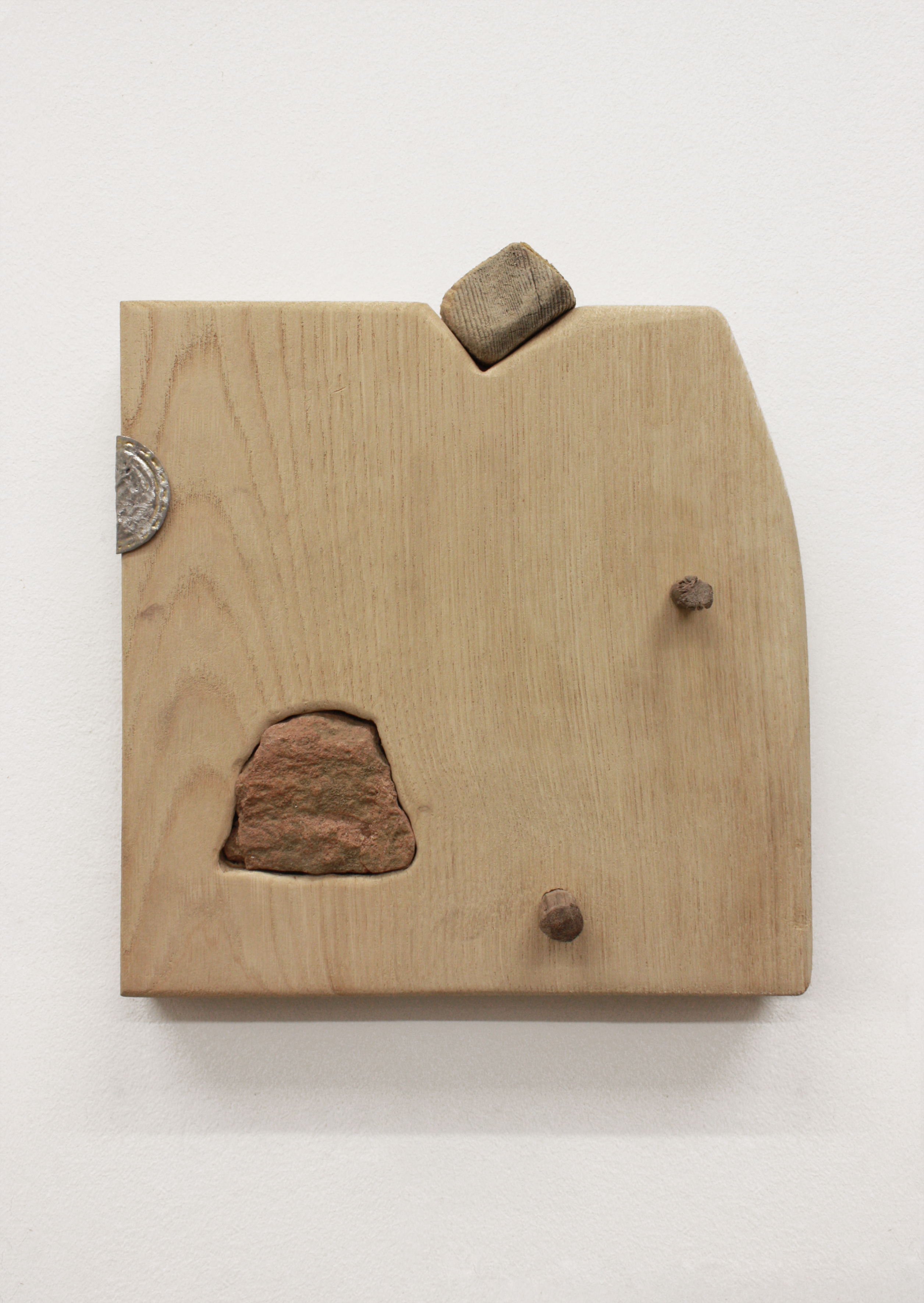
Perils in Leisure, 2018, Yew, sulphur stained Tuff, and detritus (bottle cap, rudder element and walnut pegs), 28 x 25 x 7 cm
-
If you like this why not read our interview with BenYau
-
© YAC | Young Artists in Conversation ALL RIGHTS RESERVED
